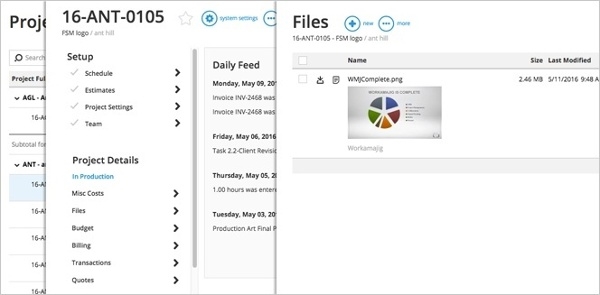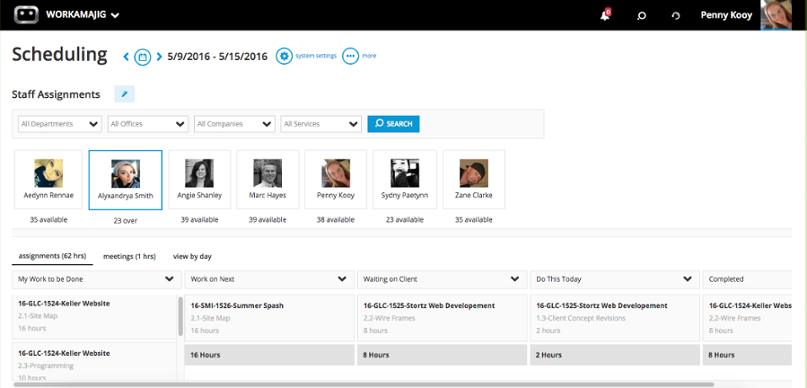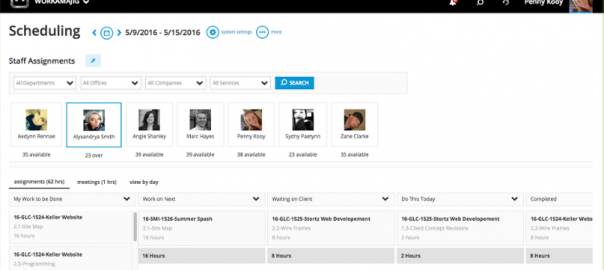— May 25, 2018
Creative project management is that particular flavor of project management that you’d use on creative projects. Whether you’re running an internal creative team or an agency, adopting better creative project management practices can transform your project success rate.
Would you use the same approach to build a website as you would to build a house?
Probably not.
Creative projects have unique demands. Your resources, for one, aren’t fungible or scalable. You can’t replace one creative director with another. Nor can you create a design 10x faster by adding 10x resources to it.
Managers new to the creative industry often struggle with these challenges. The practices that might have worked for them in other industries often fall apart when confronted with creative projects.
This article will key you into the challenges, principles, and best practices you need to excel at creative project management. Use it as a guide if you’re new to creative projects, or an old pro looking to polish his skills.
The 6 Unique Challenges in Creative Project Management
When it was first formalized, project management was meant mostly for construction, defense, and industrial projects. You can still see this legacy in the way project management methodologies describe and distribute resources.
Conventional project management, thus, is sometimes inadequate for creative projects. To deal with unique challenges, you also need unique approaches.
The first step in this process is fully understanding what you’re up against. Once you know the challenges in creative project management, you’ll be better equipped to deal with them.
1. The Clash Between Creativity and Project Management
The fundamental problem in creative project management is the disconnect between what project managers and creative people want.
As a project manager, you want to quantify things. You want to break down complex activities into smaller tasks. And you want to monitor their progress by tracking KPIs.
Creative work, however, is hard to quantify. You can’t always solve a design problem by devoting sheer man hours to it. The spontaneity that often sparks creative success escapes straightforward decomposition.
Managing the expectations of creative people while still getting them to meet deadlines (and staying within brief) is one of the biggest challenges you’ll have to face as a creative project manager.
2. Lack of Historical Data and Best Practices
In the timescale of project management, the creative field is still in its infancy. Mass TV advertising wasn’t a thing until the Mad Men era. And the web wasn’t even around until 25 years ago.
The recency of its history means that you can’t really rely on historical knowledge. On a construction project, you can look back at how things were managed 20, 50, and even a 100 years ago.
You don’t have the same luxury on creative projects.
Newer technology also has a habit of disrupting conventional workflows on creative projects. The process of laying bricks has remained largely unchanged for decades, but the tools to build a website change every few years.
This disruption due to new technologies further complicates the creative project manager’s work. You can, and should rely on conventional knowledge. But you also have to embrace newer technologies, processes, and best practices.
3. Managing Unrealistic Client Expectations

Clients frequently have unrealistic expectations and little idea how the creative process actually unfolds (Image source)
Besides dealing with fickle resources, you also have to manage the often unrealistic expectations clients have from creative projects. If you’ve ever heard a client complain about the cost of a logo that takes your designers a few minutes to create, you know what I’m talking about.
This problem stems from clients not understanding the creative process. Many clients are still used to seeing projects as a black box where the more resources you add, the faster the results.
This approach, of course, fails with creative projects. 100 programmers can’t always solve a technical bottleneck faster than two programmers can. Nor will scheduling more hours help a copywriter get over his writer’s block.
Helping clients understand the inherent complexity of creative projects is one of your key challenges.
4. Developing a Creative-Friendly Environment
Creativity does not exist in isolation. The world’s most innovative companies often spend billions of dollars to create the right environment – physical and psychological – for creativity.
One of your duties as a project manager is to help create this creative-friendly environment.
There is a physical component to this, of course. But much of it is creating an atmosphere that is conducive for creativity.
If your designers are scared of making mistakes, or if your deadlines are too tight (or too loose), you’ll struggle to get the best out of your people.
5. Facilitating Collaboration
Creative projects, more than anything else, depend on collaboration. You don’t always need extensive collaboration to run a factory. But you definitely can’t get any work done if your designers can’t collaborate on a UI/UX design.
Collaboration isn’t something you can readily implement with a few tools or policy changes. Rather, it is a deep commitment that demands changing the very nature of a business’ DNA. If transparency and sharing aren’t a part of your company’s culture, your collaboration efforts will falter.

Collaboration software, such as Workamajig, can help creative teams collaborate easily.
Bringing about this change – in the organization and in your team – is one of your biggest challenges as a creative project manager.
6. Managing Change
“What exactly do you want from this creative project?”
You’ll be surprised to hear how few clients have a clear answer to this question. Agency veterans will tell you nightmare stories of clients who want a website that “looks nice”, but fail to define what “nice” actually means.
The inherent subjectivity of creative work means that you’ll struggle with scope changes on creative projects. Your stakeholders might have a very different vision of the final product as compared to your designers. And when their vision doesn’t match up to yours, you have no recourse than to go back to the drawing board.
If the scope keeps changing at every meeting, you’re likely to overshoot either the deadline or the budget (or both).
Managing change, thus, is one of your top responsibilities as a creative project manager.
To deal with these challenges, you need to adopt a new set of principles and practices, as I’ll share below.

The 3 Principles of Creative Project Management
Dealing with creative projects demands a shift in perspective. Creative work is complex, as are the people responsible for creating it. Collaboration and empathy aren’t just buzzwords anymore; they’re guiding values for creative projects.
On that note, let’s look at some of the fundamental principles of creative project management.
Creativity
Creative teams and agencies live and die by the quality of their creative output. Meeting deadlines and staying within budget is obviously important. But if it comes at the cost of creativity, it won’t lead to a successful project or a sustainable business.
Placing creativity at the heart of the project requires a reorientation of your PM practices. You have to find a balance between meeting your objective duties (such as meeting deadlines) while fulfilling your role in nurturing creativity.
The focus on creativity extends to every facet of the business. You have to encourage diversity – within the organization as well as the team. You have to work with senior execs to create a more collaborative culture. And you have to create a welcoming creative environment.
Collaboration
Modern creative projects are rarely, if ever, isolated exercises. Even the simplest of web development projects requires input from a range of experts – designers, developers, SEO guys, etc.
This complexity demands that you put collaboration front and center in your project management practices. In some cases, you’ll have to abandon old methods sand embrace new, collaboration-focused habits.
For instance, project managers traditionally assign roles and set goals on their own. But in a collaboration-friendly environment, you’ll want to involve team members in goal setting.
Essentially, consider all problems from the collaborative lens. Ask: what can I do to help everyone work together on this problem?
Empathy
Getting the most out of creative people isn’t just about setting aggressive deadlines and managing tasks effectively. Rather, it’s about understanding them, their problems, and their perspectives.
In other words, creative project management requires empathy.
Empathy is rarely talked about in formal project management approaches, but it is vital for creative projects. Creative problems seldom have straightforward solutions; you’ll have to get people on the negotiating table and empathize with their point of view to find answers.
As Victor Lipman writes in Forbes, you have to practice a “firm direction, light touch” approach. Give them guidelines to reach the solution, then give them the space to find their own path.
Guiding principles are nice to have, but how exactly do you put them into use? I’ll share some creative project management best practices in the next section.
6 Effective Creative Project Management Strategies
Creativity. Collaboration. Empathy.
These values should be the foundation of your creative project management approach.
But principles alone can’t help you manage projects better. You also need proven best practices and tactics, like these:
1. Educate clients about the creative process
Clients who don’t understand the creative process invariably end up derailing projects. They reject your suggestions, request too many changes, and have unrealistic expectations.
This isn’t good for the project. And it is certainly not good for you.
Solve this problem by investing in client education. Guide them through the creative process. Show them the effort that goes into creating every deliverable.
This solves two issues:
- It erodes the client’s resistance to suggestions
- It helps justify your estimations – for deadlines and for budgets
Make this a part of your onboarding process. Reiterate the message at early-stage meetings.
2. Solve scope creep issues
Besides death and taxes, another inevitable thing in life is clients who don’t really know what they want from a creative project. They might have a vague idea, but they often fail to communicate it clearly.
The result is endless scope changes, frustrated clients, and delayed projects.

Scope creep can derail even the most astutely planned projects, so solve this problem as early as possible (Image source)
Managing change is one of your toughest responsibilities as a creative project manager. It demands deft handling – you want to limit change requests but also keep clients happy.
Here are some tactics you can use to manage change:
- Gather requirements: Gather as much data upfront as possible. Understand the client’s vision fully before committing to any process. You should know what the client wants, what the end-users need, and how the project will be deployed.
- Understand the project’s complexity: “Just a website” isn’t just a website; it also requires SEO, social integrations, and even some CRO. This will improve the quality of your estimations.
- Limit the number of “free” iterations: If the client exceeds that number, charge them extra for it. Make sure that clients understand this at the very start of the project.
- Get client input early: Instead of sending final designs, send clients low-cost and easy-to-modify mockups and wireframes first. Get them to sign-off on these before you build the final iterations.
3. Embrace collaboration in every facet of the team
To embrace collaboration isn’t just to switch to Slack from email; it is to create a culture that truly values working together. This means cherishing values like transparency, gratitude, sharing, and gratitude at every level of the business, from the CEO down to the interns.
You can’t do it single-handedly, of course. Nor will the change be fast. But you can start the fire by embracing collaboration in your team.
How? Here are a few tactics:
- Instead of top-down goal setting, collaborate with team members to set targets.
- Involve team members when you assign them roles. Factor in their preferences and long-term ambitions.
- Encourage senior members to reach out and mentor new people on the team. If possible, institute a formal mentorship program.
- Identify the less engaged and non-communicative members of the team. Get them involved in team activities to improve team cohesiveness.
4. Nurture different creative personalities
“Creative people” aren’t a monolith. They have different personalities that are useful in different stages of the project. As project manager, it’s your responsibility to identify and nurture these personalities.
Some of the personalities found within creative teams are:
- Adventurer: Curious, flexible, and likes to experiment with new approaches. Adventurers thrive in a crisis and love to solve tough problems.
- Navigator: Navigators have a more conventional approach to creativity. They build on proven techniques and focus on facts. Navigators are crucial for keeping the team grounded.
- Visionary: The visionary of any team is its “big picture” person, i.e. someone who challenges the team to think outside the box and pick ambitious targets.
- Explorer: The explorer is the person who rises up the visionary’s challenge. He/she is the idea person, challenging the status quo and forcing the team to think beyond accepted solutions.
- Inventor: The inventor uses proven models and theories to break down complex problems and arrive at solutions. At the same time, he/she develops new models to complement the team’s working style.
- Harmonizer: The harmonizer is the calming influence on the team. He/she is usually a relationship-focused person who smoothes out the team’s dynamics and brings out the best in people.
You’ll find that the best-performing creative teams have a mix of these personalities.
5. Close monitoring is critical
Creative projects can go off track faster than you know. A critical resource goes on leave, a client requests too many changes, and before you know it, you’re off budget and delayed by 3 weeks.

Close monitoring with tools such as Workamajig can prevent projects from going off track, and pull back derailed projects
Close monitoring is one of your most important tools in ensuring the project stays on track. Try the following to monitor the project’s progress:
- Conduct regular team meetings: Meet with your team on a weekly or bi-weekly basis. This helps ensure that you have up-to-date status information and an understanding of all open issues. You can also use meetings to address any concerns and conflicts within the team.
- Conduct regular client status meetings: The takeaways from your team meetings form the basis of your client status meetings. Share the status of the project, open issues, and any tasks that need the client’s attention. Do this as frequently as you run the team meetings, i.e. on a weekly or bi-weekly basis.
- Monitor the budget closely: Projects going off budget is a common cause of creative project failure. Make sure that you monitor spending closely. Update project financials with actual charges every week. If you’re off track, take corrective action immediately by cutting back or improving productivity.
6. Use the right software
A common point of failure is using software that isn’t specifically designed for creative projects. A conventional PM tool simply doesn’t have the features you need to manage creative projects effectively.
Here are some things you should look for in creative project management software:
- The ability to manage resources (in-house and freelance), create schedules, and forecast demand.
- Features to help you develop project estimates, schedules, and creative briefs.
- A platform to address open issues, monitor project budgets, and get client feedback.
- Time tracking, project status reporting, and communication monitoring.
- Task management, document sharing, and the ability to generate online proofs.
Workamajig has all these features and more. Click the link below to learn more about how Workamajig can help you run better creative projects.
Over to you
Creative projects require a unique set of skills. You’ll have to overcome new challenges and adopt some core principles – empathy, creativity, and collaboration – to succeed at them. You’ll also have to reorient your best practices to fit the needs of creative projects.
Business & Finance Articles on Business 2 Community
(84)









